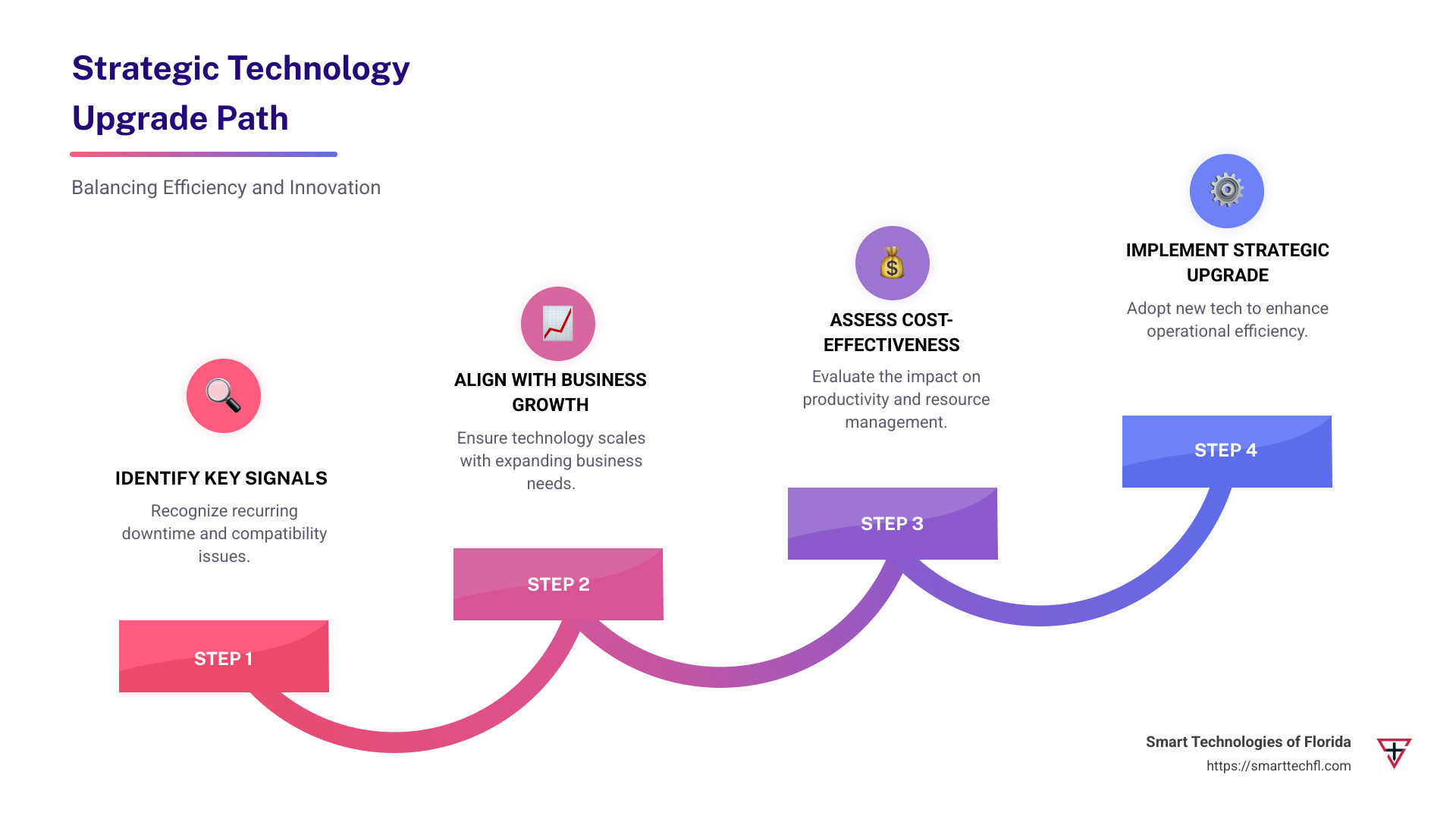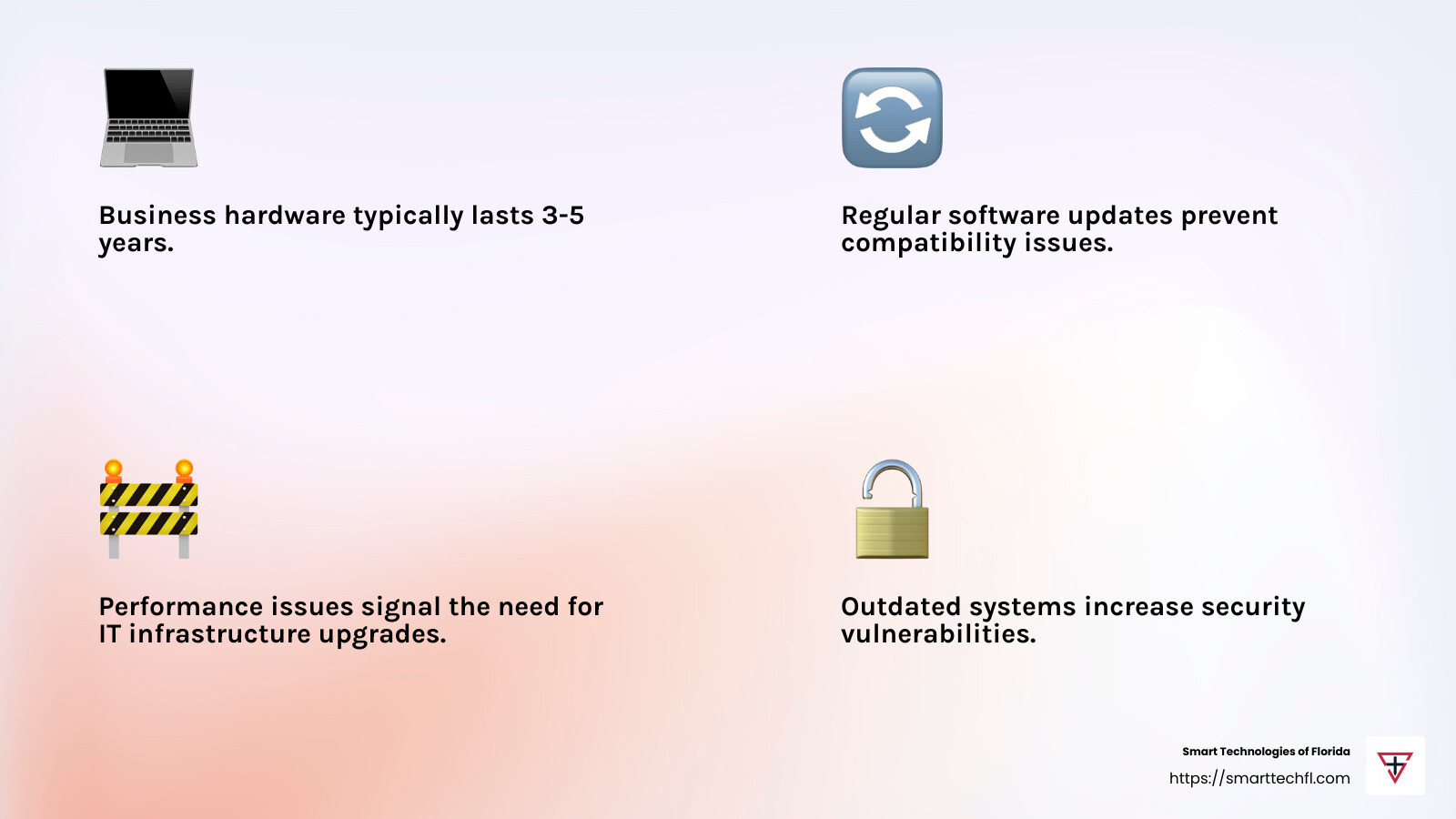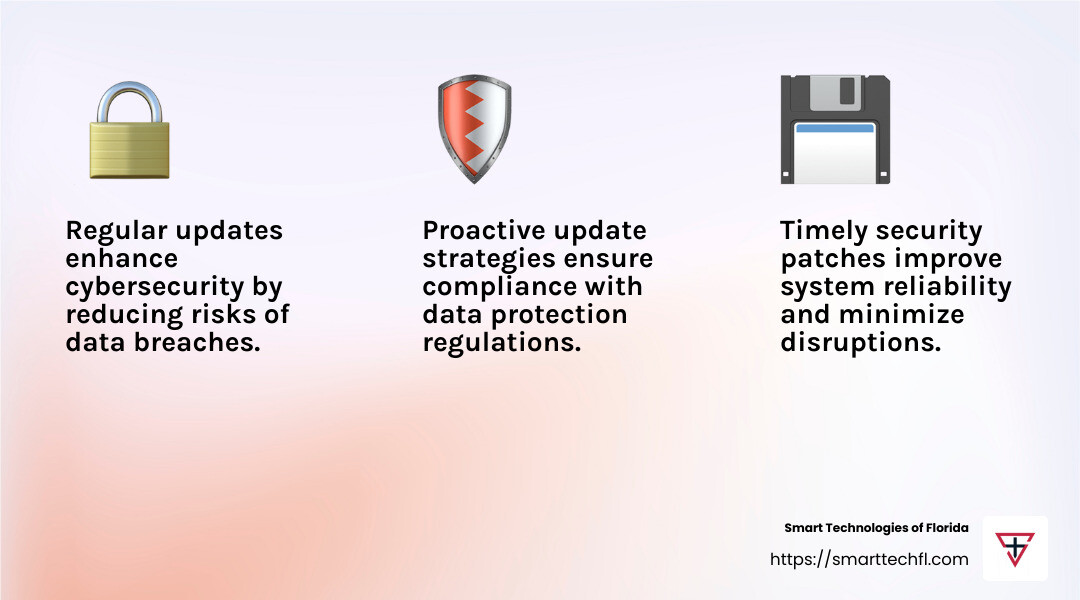Tech Tune-Up: How Often Should Your Business Upgrade?
Technology upgrade for businesses? When considering this crucial question, there isn’t a one-size-fits-all answer, but there are key signals that businesses can rely on:
- Recurring downtime: Frequent system outages disrupt productivity.
- Business growth: Expanding enterprises need scalable technology solutions.
- Direction shifts: Changes in company strategy may demand infrastructure updates.
- Compatibility issues: New technology should integrate seamlessly with current systems.
Upgrading business technology is not just a routine task; it’s a strategic move towards enhancing operational efficiency and achieving competitive advantage. For mid-sized retail business owners, navigating outdated systems can mean struggling with high costs and less effective customer engagement. However, treating technology upgrades as strategic changes rather than mere necessities can transform these challenges into opportunities for growth.
The balance between maintaining what works and embracing the new is delicate. Timing is crucial, as upgrading too early might waste resources while lagging behind could risk falling into irrelevance. To strike this balance effectively, understanding the interplay between business needs and the lifespan of technology is essential.

Understanding the Lifespan of Technology
Key Indicators for Upgrading
When considering how often does the business upgrade its technology, recognize the signs that indicate it’s time for a change. Let’s explore the critical indicators that suggest an upgrade might be necessary.
Hardware Lifespan
Typically, the lifespan of business hardware, like computers and servers, ranges from 3 to 5 years. Over time, devices show wear and tear, which can lead to performance issues. For instance, high-performance workstations used in graphic design or data analysis may require more frequent updates compared to basic office desktops.
To manage this, businesses can adopt a rolling schedule for hardware replacement. This approach allows for trial and error with new technology and spreads costs over time, minimizing disruption.
Software Updates
Software is a different beast. It demands more frequent attention due to regular updates and new technologies. Older hardware might struggle with the latest software updates, leading to compatibility challenges. As software evolves, it’s crucial to ensure systems meet the minimum requirements to avoid missing out on new features and improvements.
Using a calendar to schedule software reviews can help keep everything up-to-date without causing workplace disruptions.
IT Infrastructure Performance Issues
Performance issues like slow boot times, frequent crashes, and lagging applications are clear indicators that systems are struggling to keep up. These problems not only frustrate employees but also hinder productivity.
Regularly evaluating IT infrastructure and addressing these issues can prevent productivity slowdowns. When technology starts to slow down, it’s time to investigate potential upgrades.
Security Vulnerabilities
Security is a top priority for any business. Outdated systems are more susceptible to cyber threats because manufacturers eventually stop providing updates for older systems. This leaves them vulnerable to attacks.
Implementing regular security updates and replacing outdated technology can help protect sensitive business data.
Compatibility Challenges
As software developers release new versions, older hardware might not be compatible. This can force teams to work with outdated software, missing out on new features and improvements.
Ensuring compatibility between hardware and software is vital for seamless operations and can prevent costly disruptions.

Understanding these key indicators helps businesses determine how often does the business upgrade its technology. By regularly assessing these factors, businesses can make informed decisions about when to upgrade, ensuring they remain competitive and secure.
How Often Does the Business Upgrade Its Technology?
Determining how often does the business upgrade its technology involves balancing multiple factors. Let’s explore the key considerations.
Factors Influencing Upgrade Frequency
3-5 Years Cycle
Most businesses follow a 3-5 years cycle for upgrading technology. This timeframe strikes a balance between leveraging new advancements and avoiding premature investments. Regular upgrades within this period can improve productivity and security.
Business Growth
As a business grows, so do its technology needs. Expansion often requires more robust systems to handle increased data and user demands. Planning upgrades in anticipation of growth can prevent bottlenecks and ensure scalability.
Cybersecurity Needs
Cyber threats are constantly evolving. Keeping technology up-to-date is crucial for maintaining strong defenses. Regular upgrades help protect against vulnerabilities that older systems may have, ensuring data security and compliance.
Organizational Changes
Significant changes, like shifting to remote work or launching new services, can necessitate technology updates. These changes might require different tools or infrastructure, prompting an upgrade to align with new business operations.
Balancing Cost and Innovation
Cost-Effectiveness
Upgrading technology involves costs, but it’s important to consider the long-term benefits. Newer systems often require less maintenance and can lead to productivity gains. Weighing these benefits against the initial investment helps in making cost-effective decisions.
Productivity Gains
Modern technology can significantly boost productivity. Faster processing speeds and improved features allow employees to work more efficiently, reducing time spent on tasks and increasing output.
Budget Considerations
Budget constraints are a reality for many businesses. A phased approach to upgrades can help manage costs. This strategy involves replacing a portion of the technology each year, spreading expenses and minimizing disruptions.
Strategic Planning
Strategic planning is key in deciding when to upgrade. Aligning technology upgrades with business goals ensures that investments support growth and innovation. Regularly assessing technology needs and market trends can guide these decisions.
By understanding these factors, businesses can determine how often does the business upgrade its technology. The right timing can improve productivity, security, and adaptability, keeping the business competitive in a rapidly changing environment.
Next, we’ll explore the role of cybersecurity in upgrade decisions.
The Role of Cybersecurity in Upgrade Decisions
Importance of Regular Security Updates
Cybersecurity is not just a technical concern—it’s a business imperative. As cyber threats evolve, regular security updates become crucial for maintaining a secure and reliable IT environment.
Cyber Threats and Security Patches
Cyber threats are constantly evolving, targeting vulnerabilities in outdated systems. To combat these threats, businesses need to apply security patches promptly. These patches fix known vulnerabilities and protect against potential breaches. Ignoring them can leave your business exposed to threats like ransomware and data theft.
Risk Management and System Reliability
Regular updates are a key part of risk management. They ensure that your systems are fortified against the latest threats, reducing the risk of security incidents. By keeping your technology up-to-date, you also maintain system reliability. This means fewer disruptions and smoother operations.
Data Protection and Proactive Measures
Data protection is paramount. Regular updates help safeguard sensitive information, ensuring compliance with data protection regulations. Being proactive in your update strategy means scheduling regular checks and updates to minimize downtime and maintain business continuity.

By prioritizing cybersecurity in your upgrade decisions, you not only protect your business but also build trust with your clients and stakeholders. This proactive approach keeps your digital infrastructure robust and resilient against emerging threats.
In the next section, we’ll address frequently asked questions about technology upgrades, providing further insights into effective upgrade strategies.
Frequently Asked Questions about Technology Upgrades
How often should technology be upgraded?
Typically, businesses consider upgrading every 3-5 years. This timeframe balances the cost of new technology with the benefits of improved performance and security.
IT equipment like computers, servers, and network devices often fall into this cycle. Regular upgrades ensure systems run smoothly, support new software, and meet growing business needs.
Business needs also drive the upgrade frequency. If your company is expanding or adopting new services, it might require more frequent updates to handle increased demands.
Why do technology companies often upgrade their products?
Technology companies frequently release upgrades to offer improved processing power, robust security, and reduced downtime.
Advancements in processors and memory improve speed and efficiency, allowing businesses to handle more complex tasks quickly. Upgraded security features protect against the latest threats, reducing the risk of cyber attacks. Additionally, newer technology tends to be more reliable, minimizing downtime and maintenance costs.
How does technology advancement impact upgrade frequency?
Technology advancement follows a pattern known as the doubling rate. This means that processing power and capabilities tend to double approximately every 18-24 months.
This rapid pace of innovation affects the trend curve for upgrades. As new technologies emerge, they set higher standards for performance and security. Businesses that keep up with this innovation pace can maintain a competitive edge, offering better services and experiences to their customers.
In the following sections, we’ll dive deeper into strategic approaches to upgrading technology, ensuring your business stays ahead in a fast-evolving digital world.
Conclusion
At Smart Technologies of Florida, we understand that upgrading your business technology is not just about keeping up with the latest trends—it’s about strategic change that aligns with your unique goals. Our approach is people-centric, focusing on empowering businesses through custom digital solutions.
Strategic Change: As a Business Change Agency with 23 years of experience, we specialize in tailoring digital solutions that fit your specific needs. Whether it’s upgrading your IT infrastructure or adopting new technologies, we ensure that every change supports your business objectives and improves your operational efficiency.
Custom Digital Solutions: We believe in crafting solutions that are as unique as your business. Our team works closely with you to understand your challenges and aspirations, ensuring that our technology upgrades provide tangible benefits, from increased productivity to improved security.
Partnering for Success: By collaborating with us, you gain a partner committed to your growth. We help you steer the complexities of technology upgrades, balancing cost and innovation to deliver solutions that drive your success in the digital age.
Ready to transform your business with strategic technology upgrades? Explore our custom digital solutions and see how we can help you achieve excellence through innovation. Let’s work together to keep your business ahead in a fast-evolving digital world.












